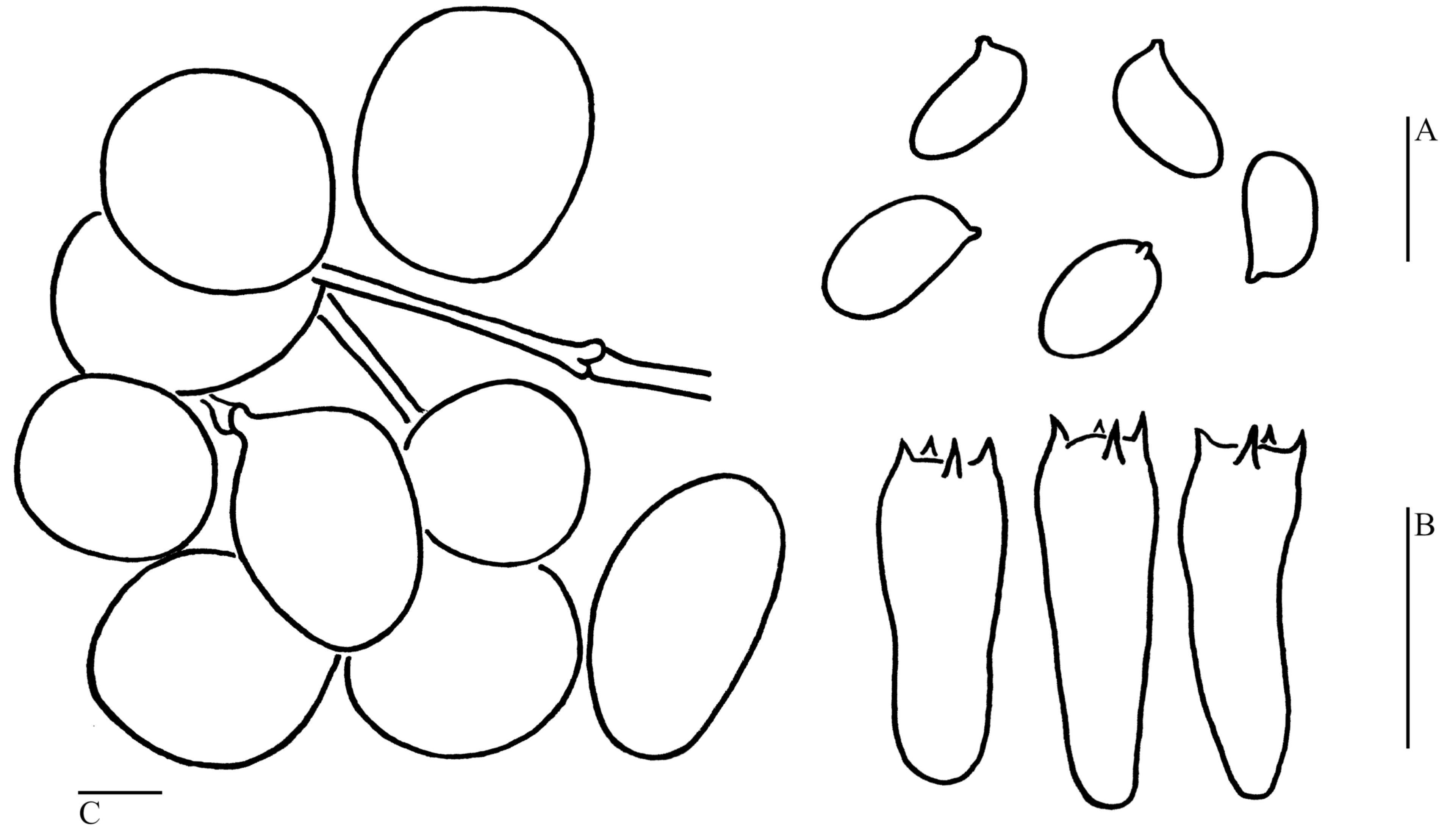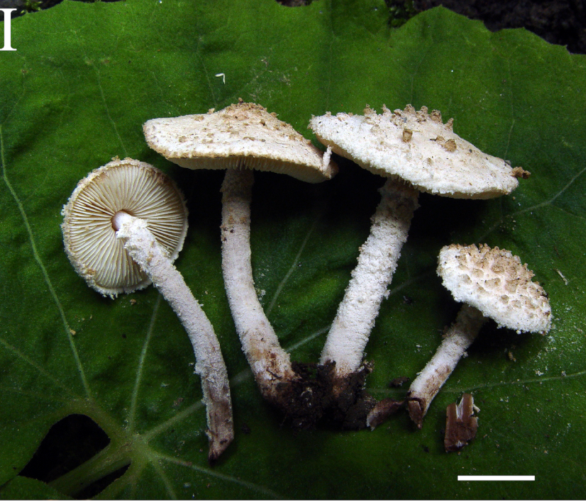锥鳞囊小伞Cystolepiota pyramidosquamulosa
Y.J. Hou, H. Qu & Z.W. Ge 2023
基本信息 | - 通用中文名Chinese name:锥鳞囊小伞
- 拉丁学名Scientific name:Cystolepiota pyramidosquamulosa Y.J. Hou, H. Qu & Z.W. Ge 2023
- 科family:疣孢环柄菇科Verrucosporaceae
- 属Genus:囊小伞属Cystolepiota
- 分布Distribution:中国、印度、意大利
- 有分布的省区Provinces:四川省(文献记载)
查看具体分布情况 - 生态Ecology:单生或散生于土壤
- 营养类型Nutrition Type:腐生Saprotrophic: 分解死亡生物体或有机物获取养分
- 置信指标Confidence:★★★
|
介绍部分
简介:锥鳞囊小伞是囊小伞属的一个物种,在属内其显著特征为褐色、较大的锥形鳞片。另外,其菌柄的中上部有菌环状结构,担孢子在显微镜下光滑,非淀粉质非类糊精质,存在锁状联合。
相似物种
其他囊小伞通常有粉末状至颗粒状鳞片。分布于老挝和泰国的
Cystolepiota pyramidalis在鳞片上和本种相似但它拥有褶缘囊状体,孢子椭圆至卵形,而本物种椭圆、长椭圆至圆柱形。
Pulverolepiota oliveirae和
Pulverolepiota petasiformis同样有明显的鳞片并缺乏囊状体,但它们的担孢子粗糙,在梅氏试剂中缓慢变棕红色,菌盖鳞片由不规则、分支、末端膨大或长方形的细胞组成,而本种则是由菌丝和膨大球形细胞组成。
物种介绍引证的参考文献
(上文介绍部分中所引用的参考文献)
- Taxonomy and Phylogeny of Cystolepiota (Agaricaceae, Agaricales): New Species, New Combinations and Notes on the C. seminuda Complex, 2023. Hua Qu, Ulrike Damm, Ya-Jun Hou, Zai-Wei Ge. J. Fungi 9(5) https://doi.org/10.3390/jof9050537
涉及到该物种的相关文献
(能证明该种在我国有分布的文献)
- Taxonomy and Phylogeny of Cystolepiota (Agaricaceae, Agaricales): New Species, New Combinations and Notes on the C. seminuda Complex, 2023. Hua Qu, Ulrike Damm, Ya-Jun Hou, Zai-Wei Ge. J. Fungi 9(5) https://doi.org/10.3390/jof9050537
物种描述
以下描述摘自相关参考文献,仅供参考。可能存在文献过时、描述错误或者描述片面等情况
文字识别时可能有纰漏,描述若与参考文献原文有出入以原文为准
外文描述的参考翻译系网站管理者的个人翻译,仅供参考,具体以原文为准
描述1 描述来源:Taxonomy and Phylogeny of Cystolepiota (Agaricaceae, Agaricales): New Species, New Combinations and Notes on the C. seminuda Complex类型:原白(物种发表时的原始描述)
描述原文:
Cystolepiota pyramidosquamulosa H. Qu & Z. W. Ge sp. nov. Figure 3I, Figure 4L and Figure 7.
MycoBank: MB845060.
Etymology: The epithet “pyramidosquamulosa” refers to the pyramidal squamules on the pileus.
Diagnosis: Cystolepiota pyramidosquamulosa is distinguished from all other Cystolepiota species by its brownish, relatively large, irregular pyramidal squamules on the pileus, an annulus-like zone on the upper portion of the stipe, the smooth-walled (under LM and SEM), inamyloid, and non-dextrinoid basidiospores, the absence of cystidia, and the presence of clamp connections. Its ITS, LSU, rpb2, and tef1 sequences are distinct from other species.
Type: China, Sichuan Province, Aba Tibetan and Qiang Autonomous Prefectures, Maerkang (Barkam) City, Dangba Township, Yinlang Village, on soil, 17 August 2007, Z. W. Ge 1900 (Holotype, KUN-HKAS 53985). GenBank: ITS = OP059088, LSU = OP059068, rpb2 = OP104335, tef1 = OP141792.
Description: Pileus 24–28 mm in diam, convex to plano-convex with an indistinct broad umbo; surface white, covered with concolorous flocculose squamules and brownish (5B4-5) irregular pyramidal squamules (up to 5 mm in height) that spread out towards the margin and can easily be wiped off; margin with overhanging squamules similar to those on the pileus. Lamellae free, close, up to 2.5 mm wide, yellowish-white (2A3), with 1–3 tiers of lamellulae; lamellae margin smooth. Stipe 30–45 × 15–25 mm, central, cylindrical, with a slightly expanded base, hollow, stuffed with white fibers, brownish (5B4-5); glabrous or slightly pruinose at the apex, with an annulus-like zone on the upper part covered with similar squamules as the pileus; squamules on lower portion cream to yellowish white (2A2-3), flocculose or pulverulent. Context of stipe and pileus cream to brownish (5B4). Smell and taste were not recorded.
Basidiospores [100/5/1] (3.5–)4–5 (–5.5) × (1.5–)2–3 μm, Q = (1.44–)1.60–2.28(–2.47), Qm = 1.95 ± 0.20, ellipsoid to elongate, sometimes cylindrical, colorless, thin-walled, smooth-walled under the LM and SEM (Figure 4L); inamyloid, non-dextrinoid, metachromatic in cresyl blue. Basidia (13.5–)15–18.5 × 5–7 μm, clavate, hyaline, 4-spored; sterigmata 2.5–3.5 μm long. Cheilocystidia and pleurocystidia not observed. Lamellar trama regular, colorless, composed of cylindrical hyphae, 5–7.5 μm in diam. The squamules on pileus and stipe consist of inflated cells and filamentous hyphae; inflated cells abundant, globose to subglobose, rarely fusiform or sphaero-pedunculate, 21–33 × 20–29 µm, smooth-walled, with a slightly thick, chartreuse-yellow wall, usually 2–5 cells forming loosely arranged chains; hyphae rare, 1–3 µm in diam, chartreuse-yellow. Clamp connections present in all tissues (Figure 7).
Habitat and distribution: Presumably saprotrophic. Solitary or scattered on soil. Found in Asia (China, India) and Europe (Italy).
Notes: Pyramidal squamules are the most distinctive macroscopic characteristic of Cystolepiota pyramidosquamulosa. The pilei of P. oliveirae and P. petasiformis (=P. pulverulenta) are also covered with obvious squamules and also lack cystidia. However, the two species can be distinguished from C. pyramidosquamulosa by the rough basidiospores that slowly become red-brown in Melzer’s reagent and the squamules composed of irregular, branched, inflated, and oblong elements. In addition, the basidiospores of C. pyramidosquamulosa are narrower than those of the latter two species [5,55,56]. Cystolepiota pyramidalis Sysouph. and Thongkl. forms squamules similar to C. pyramidosquamulosa. However, C. pyramidalis forms cheilocystidia and ellipsoid–ovoid spores and has so far only been collected in Laos and Thailand [57]. In contrast to C. pyramidosquamulosa, C. fumosifolia (Murrill) Vellinga and C. pseudofumosifolia M.L. Xu & R.L. Zhao form warty to granulose squamules and have cystidia [5,58]. Cystolepiota adulterina F.H. Møller ex Bon has warty squamules and somewhat resembles C. pyramidosquamulosa macroscopically. However, it differs in the presence of abundant cheilocystidia. In addition, C. pyramidosquamulosa can be distinguished from other species by its distinct ITS, LSU, rpb2, and tef1 sequences.
Two ITS sequences from GenBank, JF907983 (from Italy) and KU847887 (from India), are similar to the sequence derived from the type specimen of C. pyramidosquamulosa; both differ by seven nucleotides from C. pyramidosquamulosa, which is considered within the variability of C. pyramidosquamulosa.
库中图片 2 张
标签:[无]
上次编辑:2025-10-15
物种编号:1015
Revised:true
本页向外链接的参考文献:总计 5 条链接(含重复)
重定向至本页的页面:总计 0 条链接
©菌物志Mycopedia
回到首页 搜索物种 目录
©菌物志Mycopedia,版权声明
如需引用本文可参考下列格式:
蔡佳铭.2025. 锥鳞囊小伞Cystolepiota pyramidosquamulosa. 菌物志Mycopedia. http://www.mycopedia.top/result.php?details=Cystolepiota pyramidosquamulosa
Jia-Ming Cai.2025. Cystolepiota pyramidosquamulosa [Chinese]. Mycopedia. http://www.mycopedia.top/result.php?details=Cystolepiota pyramidosquamulosa


